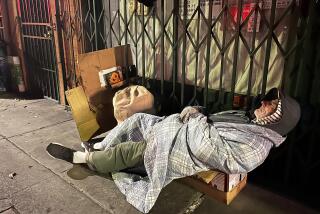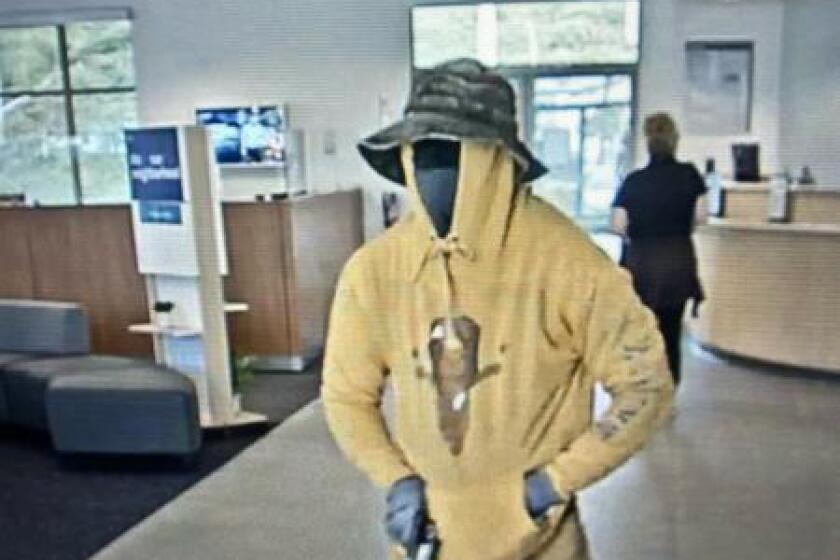Harry Pregerson: Justice for L.A.’s Homeless : Wide-Ranging Judge Opens One of First Federal Shelters
Harry Pregerson is a judge who does not believe that the power of the federal judiciary ought necessarily to be confined to the courtroom, or to the limits of federal law, either, for that matter.
Pregerson, 64, a member of the U.S. 9th Circuit Court of Appeals, has pounded his gavel all over town.
Presiding over the decades-long Century Freeway dispute, a case he described as “part of my life, my work,” Pregerson was as likely to hold court out next to the bulldozers as in the federal Courthouse downtown.
As a retired Marine shot in the leg at Okinawa, Pregerson makes annual treks to the wilds of New Mexico to distribute toys to Navajo youngsters as part of the corps’ “Toys for Tots” program.
And last winter, when one of downtown Los Angeles’ few shelters for the homeless closed during a numbing cold spell, Pregerson dispatched his law clerks to research a little-used provision of federal law that allows the government to make surplus federal property available to the homeless.
First Shelter to Open
And tonight, after 12 months of meetings, telephone calls, letters and applications shepherded by Pregerson--the first shelter for the homeless on federal property in California is scheduled to open at 6 p.m. in an abandoned federal warehouse in Bell.
“Judges do a lot of things other than judging,” Pregerson said. “I don’t know. I just get into these things, and one thing leads to another, you know? You can’t plan life, can you?”
The fact was that for years, nothing had led to anything when it came to the federal government doing something about the homeless problem in Southern California.
Even after the law was amended in 1986 to set up a structure for using surplus federal property for shelters, no one seemed able to clear the bureaucratic hurdles, said Gene Boutilier, who coordinates federal assistance programs for the United Way in Los Angeles. Seattle had been the only city in the nation to open a shelter on federal property.
‘Bureaucratic Barriers’
In Los Angeles, city officials discussed opening a shelter at Ft. MacArthur, or on federal property near the Santa Fe Dam.
“It didn’t work. The bureaucratic barriers were just impossible,” Boutilier said. “There are residential concerns about siting any kind of community service, not just homeless shelters.”
City officials in Bell were suspicious about opening a shelter at the 134-acre Federal Supply Service Center near the Long Beach Freeway. They worried that Bell was going to get stuck with downtown Los Angeles’ homeless problem, that hordes of shelter tenants milling about during the day might present a security threat to nearby business tenants.
Local General Services Administration officials did not win immediate approval from Washington.
But that is when Pregerson went to work.
The jurist met with leaders of the Salvation Army, who agreed to manage the shelter. He huddled with local GSA official Louise Oliver, who began a campaign to convince top-level bureaucrats of the merits of the plan. He attended Bell City Council meetings, persuading city officials that they would have an opportunity to review the site again after its first 90 days of operation.
Settled on Plan
Pregerson, Oliver and Lt. Col. David P. Riley, divisional commander for the Salvation Army in Southern California, settled on a plan to focus the shelter on serving the homeless population of Southeast Los Angeles.
Tenants at Salvation Army centers in the region would be bused to the shelter at night, given a hot meal and a warm cot, and bused back to collection points the following morning for more extensive counseling and assistance programs.
It is an expensive way to run a shelter, but Pregerson sold his brother-in-law and nephew, Guilford and Emerson Glazer, on the idea. And then he mentioned it to a longtime friend, wealthy real estate developer Nathan Shapell, and among the three of them they managed to come up with $50,000 to finance the shelter through its first three months.
“This is, to my knowledge, the first time in California and one of the first in the country where federal facilities have been made available to a private, nonprofit agency,” said Russell Prince, director of development for the Salvation Army.
Collection Points
Salvation Army officials say the facility will house up to 100 a night, and can be expanded to 200 beds a night if the idea works. Collection points for the homeless are the Huntington Park Corps Community Center, 6002 Rita Ave.; the Eastmont Corps Community Center, 5280 E. Beverly Blvd.; and the Belvedere Gardens Corps Community Center, 140 Eastman Ave. North.
“It’s basically a GSA-Salvation Army project, and what we’re hoping is that if this works, and there’s no reason why it shouldn’t, then it can serve as a model or a stimulus for other projects involving the federal government,” Pregerson said.
“It’s been a long road,” the judge said. “But I never realized there were so many good, decent, kind, compassionate people out there.
“I think that we’re all becoming aware that there’s a great social responsibility that we all have to do something to help people that are unfortunate, homeless, and who have really very little support from the community at large. So, I mean, I’m just happy it worked out.”
More to Read
Sign up for Essential California
The most important California stories and recommendations in your inbox every morning.
You may occasionally receive promotional content from the Los Angeles Times.










